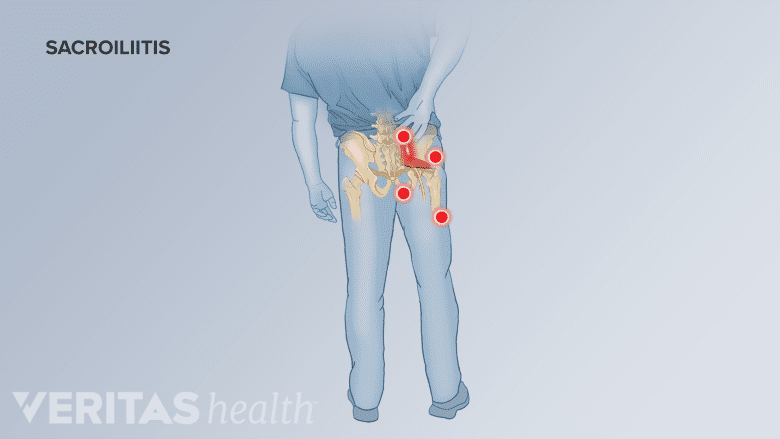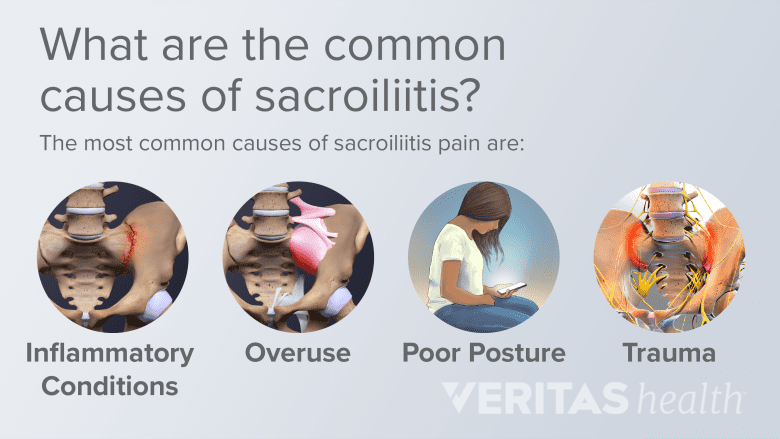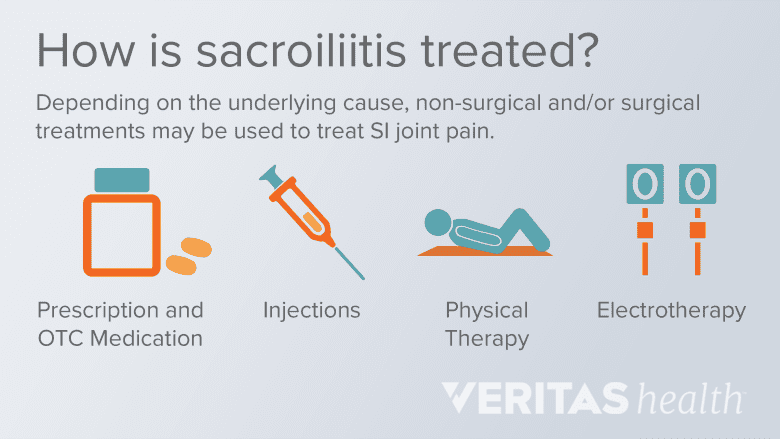The term sacroiliitis is used to describe inflammation of the sacroiliac (SI) joint, which is located on each side of the sacrum (lower spine) and connects the base of the spine to the hip bone.
Sacroiliitis typically causes pain in the lower back, buttocks, and legs and may occur due to injury, infection, or autoimmune disorders.1Baronio M, Sadia H, Paolacci S, et al. Etiopathogenesis of sacroiliitis: implication for assessment and management. Korean J Pain. 2022;33(4):294-304. http://doi.org/10.3344/kjp.2020.33.4.294 Research suggests that 10% to 25% of lower back pain may be caused by SI joint inflammation.2Buchanan BK, Varacallo M. Sacroiliitis. [Updated 2022 Sep 4]. In: StatPearls [Internet]. Treasure Island (FL): StatPearls Publishing; 2022 Jan-. Available from: https://www.ncbi.nlm.nih.gov/books/NBK448141/
In This Article:
The Sacroiliac Joint: Where It Is and What It Does

The SI joint connects the sacrum with the pelvis.
The sacroiliac joint is one of the largest joints in the body,2Buchanan BK, Varacallo M. Sacroiliitis. [Updated 2022 Sep 4]. In: StatPearls [Internet]. Treasure Island (FL): StatPearls Publishing; 2022 Jan-. Available from: https://www.ncbi.nlm.nih.gov/books/NBK448141/ located at the junction of the sacrum (the triangular bone at the bottom of the spine) and the ilium (the largest part of the hip bone). This C-shaped joint is 1-2 mm wide and lined by a thin layer of tissue that produces a lubricating fluid called synovial fluid.1Baronio M, Sadia H, Paolacci S, et al. Etiopathogenesis of sacroiliitis: implication for assessment and management. Korean J Pain. 2022;33(4):294-304. http://doi.org/10.3344/kjp.2020.33.4.294 The synovial fluid helps reduce friction and allows for smooth movement between the joint surfaces.
Watch Sacroiliac (SI) Joint Anatomy Video
Major Functions of The Sacroiliac Joint
The sacroiliac joint is essential for stability and shock absorption between the upper and lower body. The motion within the SI joints is limited and ranges between 2 to 3 degrees.1Baronio M, Sadia H, Paolacci S, et al. Etiopathogenesis of sacroiliitis: implication for assessment and management. Korean J Pain. 2022;33(4):294-304. http://doi.org/10.3344/kjp.2020.33.4.294
- The joints allow functions like walking, standing, standing, sitting, and getting into (or getting up from) a lying-down position.3Eshed I, Miloh-Raz H, Dulitzki M, et al. Peripartum Changes of the Sacroiliac Joints on MRI: Increasing Mechanical Load Correlating with Signs of Edema and Inflammation Kindling Spondyloarthropathy in the Genetically Prone." Clinical Rheumatology. 2015; 34(8):1419-1426. http://doi.org/10.1007/s10067-015-2976-0
- The synovial fluid in the SI joint helps absorb and distribute forces directed from the spine to the legs and from the lower body to the spine.3Eshed I, Miloh-Raz H, Dulitzki M, et al. Peripartum Changes of the Sacroiliac Joints on MRI: Increasing Mechanical Load Correlating with Signs of Edema and Inflammation Kindling Spondyloarthropathy in the Genetically Prone." Clinical Rheumatology. 2015; 34(8):1419-1426. http://doi.org/10.1007/s10067-015-2976-0,4Cramer GD, Ro CS. Chapter 8 – The sacrum, Sacroiliac Joint, and Coccyx. In: Cramer GD, Darby SA, eds. Clinical Anatomy of the Spine, Spinal Cord, and Ans. 3rd ed. Mosby; 2014:312-339. http://doi.org/10.1016/B978-0-323-07954-9.00008-6.
An extensive architecture of tough and resilient ligaments helps support the sacroiliac joints, permitting stable yet flexible support to the upper body.
Sacroiliitis: Common Symptoms and Signs

Sacroiliitis may cause SI joint pain affecting the lower back, buttocks, thighs, and legs.
Sacroiliitis may affect one or both the SI joints. The condition is often characterized by some combination of the following symptoms and signs:5Cohen SP, Chen Y, Neufeld NJ. Sacroiliac joint pain: a comprehensive review of epidemiology, diagnosis and treatment. Expert Rev Neurother. 2013;13(1):99-116. http://doi.org/10.1586/ern.12.148
- Localized pain. Buttock pain on the affected side is the most common symptom of sacroiliitis. Some patients may also experience pain in the middle of the lower back area.2Buchanan BK, Varacallo M. Sacroiliitis. [Updated 2022 Sep 4]. In: StatPearls [Internet]. Treasure Island (FL): StatPearls Publishing; 2022 Jan-. Available from: https://www.ncbi.nlm.nih.gov/books/NBK448141/
- Radiating pain. The pain may go down one or both thighs, legs, and/or feet.6Dydyk AM, Forro SD, Hanna A. Sacroiliac Joint Injury. [Updated 2023 Jan 15]. In: StatPearls [Internet]. Treasure Island (FL): StatPearls Publishing; 2023 Jan-. Available from: https://www.ncbi.nlm.nih.gov/books/NBK557881/ In some cases, the pain may radiate into the upper back area.2Buchanan BK, Varacallo M. Sacroiliitis. [Updated 2022 Sep 4]. In: StatPearls [Internet]. Treasure Island (FL): StatPearls Publishing; 2022 Jan-. Available from: https://www.ncbi.nlm.nih.gov/books/NBK448141/
- Stiffness. Stiffness may occur in the lower back and hip, especially in the morning or after long periods of inactivity.
- Reduced function. Mobility in the lower back and legs may be reduced, making it difficult to perform activities such as bending over or lifting heavy objects.
Around 2% to 4% of patients may experience groin or lower abdomen pain from sacroiliitis. It is important to note that groin and lower abdominal pain may also indicate serious medical conditions, such as cauda equina syndrome or infection, so if these symptoms occur, immediate medical attention is warranted.2Buchanan BK, Varacallo M. Sacroiliitis. [Updated 2022 Sep 4]. In: StatPearls [Internet]. Treasure Island (FL): StatPearls Publishing; 2022 Jan-. Available from: https://www.ncbi.nlm.nih.gov/books/NBK448141/
How Sacroiliitis Occurs: Inflammatory, Mechanical, and Traumatic Causes

Sacroiliitis can be caused by inflammatory, mechanical, postural, and traumatic causes.
Inflammatory conditions most commonly cause sacroiliitis, but the condition can also occur due to trauma or prolonged stress on the SI joint.
- Inflammatory causes. Inflammatory causes of SI joint inflammation include rheumatic and autoimmune conditions, such as ankylosing spondylitis, arthritis, and inflammatory bowel diseases (Crohn's disease or ulcerative colitis).7Slobodin G, Rimar D, Boulman N, et al. Acute sacroiliitis. Clin Rheumatol. 2016;35:851-856. http://doi.org/10.1007/s10067-016-3200-6
- Mechanical causes. Mechanical causes of SI joint inflammation include activities that stress the joint, such as jobs that require heavy lifting or prolonged sitting or standing.8Lee A, Gupta M, Boyinepally K, Stokey PJ, Ebraheim NA. Sacroiliitis: A Review on Anatomy, Diagnosis and Treatment. Advances in Orthopedics. 2022. http://doi.org/10.1155/2022/3283296 Pregnancy and obesity can also increase the risk of SI joint inflammation due to changes in the ligament and tissues around the joint.9Fenton DS. Chapter 63 – Sacroiliitis. In: Czervionke LF, Fenton DS, eds. Imaging painful spine disorders. 1st ed. Saunders; 2011:476-481. https://doi.org/10.1016/B978-1-4160-2904-5.00063-X
- Traumatic causes. Traumatic causes of SI joint inflammation include sudden, acute injuries to the joint, such as fractures, dislocations, or ligament sprains that mostly occur due to falls or motor vehicle accidents.1Baronio M, Sadia H, Paolacci S, et al. Etiopathogenesis of sacroiliitis: implication for assessment and management. Korean J Pain. 2022;33(4):294-304. http://doi.org/10.3344/kjp.2020.33.4.294
In rare cases, inflammation of the SI joint can be caused by infections.10Adams TL, Marchiori DM. Arthritides. In: Clinical Imaging. Elsevier; 2014:476-624. http://doi.org/10.1016/B978-0-323-08495-6.00009-9
Sacroiliitis and SI Joint Dysfunction: Understanding the Key Difference
Sacroiliitis and SI joint dysfunction can cause similar signs and symptoms, but both these conditions are distinct.
- Sacroiliitis. In sacroiliitis, the surface lining of the bone that surrounds the SI joint gets inflamed. This inflammation results in the joint surfaces abnormally rubbing against each other during movement, causing pain.10Adams TL, Marchiori DM. Arthritides. In: Clinical Imaging. Elsevier; 2014:476-624. http://doi.org/10.1016/B978-0-323-08495-6.00009-9
- SI joint dysfunction. SI joint dysfunction is a disorder of the SI joint that affects the movement and alignment of the SI joint. It is caused by an abnormal motion of the SI joint, such as too much motion or too little motion in the joint, causing pain.
Over time, SI joint dysfunction may result in joint inflammation, leading to sacroiliitis.
The 4 Stages of Sacroiliitis: How the Condition Progresses
The progression of sacroiliitis can vary depending on the underlying cause or individual contributing factors. Generally, four stages of sacroiliitis have been identified, which can be observed on imaging tests, such as x-ray and magnetic resonance imaging (MRI).9Fenton DS. Chapter 63 – Sacroiliitis. In: Czervionke LF, Fenton DS, eds. Imaging painful spine disorders. 1st ed. Saunders; 2011:476-481. https://doi.org/10.1016/B978-1-4160-2904-5.00063-X
- Early sacroiliitis. In the early stages of sacroiliitis, there may be mild inflammation in the joint. In this stage, the joint’s mobility is normal, and the inflammation may be reversible with proper targeted treatment like activity modification and exercise. This stage is typically symptomless.7Slobodin G, Rimar D, Boulman N, et al. Acute sacroiliitis. Clin Rheumatol. 2016;35:851-856. http://doi.org/10.1007/s10067-016-3200-6
- Acute sacroiliitis. In this stage, the inflammation progresses, and pain and stiffness may be experienced in the lower back, hips, and thighs. There may be minor signs of hardening of the bone surrounding the joint. Mild to moderate pain may be experienced at this stage.7Slobodin G, Rimar D, Boulman N, et al. Acute sacroiliitis. Clin Rheumatol. 2016;35:851-856. http://doi.org/10.1007/s10067-016-3200-6
- Moderate sacroiliitis. In this stage, the symptoms of pain, stiffness, and limited mobility become more persistent and severe. Radiographic imaging reveals erosion of the SI joint and signs of either hardening or widening of the SI joint.7Slobodin G, Rimar D, Boulman N, et al. Acute sacroiliitis. Clin Rheumatol. 2016;35:851-856. http://doi.org/10.1007/s10067-016-3200-6
- Advanced sacroiliitis. In the advanced stage of sacroiliitis, the joint may become permanently damaged, leading to chronic pain and limited mobility. On imaging tests may reveal a lack of joint space between the bones in the joint.7Slobodin G, Rimar D, Boulman N, et al. Acute sacroiliitis. Clin Rheumatol. 2016;35:851-856. http://doi.org/10.1007/s10067-016-3200-6
Advanced sacroiliitis is rare and usually occurs in individuals with certain underlying conditions such as ankylosing spondylitis or psoriatic arthritis.11Slobodin G, Hussein H, Rosner I, Eshed I. Sacroiliitis—early diagnosis is key. Journal of Inflammation Research. 2018;11:339-344. http://doi.org/10.2147/JIR.S149494 Early detection and treatment of these conditions may help prevent or slow joint damage and the progression of the disease.11Slobodin G, Hussein H, Rosner I, Eshed I. Sacroiliitis—early diagnosis is key. Journal of Inflammation Research. 2018;11:339-344. http://doi.org/10.2147/JIR.S149494
How Sacroiliitis Responds to Treatment

Most cases of sacroiliitis can be treated with non-surgical treatments.
Some acute cases of sacroiliitis may resolve with rest, but most cases typically need some form of treatment including pain medication, activity modifications, and/or physical therapy. Research indicates that up to 95% of patients recover from sacroiliac joint pain with non-surgical treatments within 1 to 3 months.12Zelle BA, Gruen GS, Brown S, George S. Sacroiliiac joint dysfunction: evaluation and management. Clin J Pain. 2005; 21:446-355. https://pubmed.ncbi.nlm.nih.gov/16093751/
Surgery for sacroiliitis is rare and only indicated in select patients who have not responded to non-surgical treatments for several months or if a medical condition that warrants surgery, such as a tumor, is diagnosed.
If left untreated, sacroiliitis can become chronic, causing ongoing pain, stiffness, and limited mobility. In rare cases, permanent joint damage may occur.1Baronio M, Sadia H, Paolacci S, et al. Etiopathogenesis of sacroiliitis: implication for assessment and management. Korean J Pain. 2022;33(4):294-304. http://doi.org/10.3344/kjp.2020.33.4.294
Living with Sacroiliitis: Challenges and Impact on Daily Life
Living with sacroiliitis can be a challenging experience, as the pain and discomfort associated with the condition can affect various aspects of daily life including:
- Mobility and physical limitations. Pain and stiffness in the lower back and hips can limit one’s mobility and make it difficult to perform daily tasks like bending, walking, and sitting.
- Sleep disturbances. Pain and discomfort caused by sacroiliitis can make it difficult to find a comfortable sleeping position and potentially lead to sleep deprivation causing fatigue and other associated chronic symptoms.13Haghayegh S, Khoshnevis S, Smolensky MH, Diller KR, Castriotta RJ. Before-bedtime passive body heating by warm shower or bath to improve sleep: A systematic review and meta-analysis. Sleep Medicine Reviews. 2019;46:124-135. http://doi.org/10.1016/j.smrv.2019.04.008
A physician or physical therapist who specializes in treating SI joint pain can help with lifestyle and sleep modifications to reduce SI joint stress and improve the symptoms.
When to See a Doctor
It is advised to see a doctor for sacroiliitis if:
- Symptoms of pain in the lower back, buttocks, hips, or legs do not improve with rest and/or over-the-counter medications
- It is difficult to walk or perform everyday activities due to stiffness or limited range of motion
- The symptoms and signs begin to worsen progressively
- A fever of 101º or more is present
- There is a history of autoimmune diseases in the family
- There is unexplained weight loss and nausea
Sacroiliitis symptoms that occur after an accident or trauma are also cause for prompt medical evaluation.
- 1 Baronio M, Sadia H, Paolacci S, et al. Etiopathogenesis of sacroiliitis: implication for assessment and management. Korean J Pain. 2022;33(4):294-304. http://doi.org/10.3344/kjp.2020.33.4.294
- 2 Buchanan BK, Varacallo M. Sacroiliitis. [Updated 2022 Sep 4]. In: StatPearls [Internet]. Treasure Island (FL): StatPearls Publishing; 2022 Jan-. Available from: https://www.ncbi.nlm.nih.gov/books/NBK448141/
- 3 Eshed I, Miloh-Raz H, Dulitzki M, et al. Peripartum Changes of the Sacroiliac Joints on MRI: Increasing Mechanical Load Correlating with Signs of Edema and Inflammation Kindling Spondyloarthropathy in the Genetically Prone." Clinical Rheumatology. 2015; 34(8):1419-1426. http://doi.org/10.1007/s10067-015-2976-0
- 4 Cramer GD, Ro CS. Chapter 8 – The sacrum, Sacroiliac Joint, and Coccyx. In: Cramer GD, Darby SA, eds. Clinical Anatomy of the Spine, Spinal Cord, and Ans. 3rd ed. Mosby; 2014:312-339. http://doi.org/10.1016/B978-0-323-07954-9.00008-6.
- 5 Cohen SP, Chen Y, Neufeld NJ. Sacroiliac joint pain: a comprehensive review of epidemiology, diagnosis and treatment. Expert Rev Neurother. 2013;13(1):99-116. http://doi.org/10.1586/ern.12.148
- 6 Dydyk AM, Forro SD, Hanna A. Sacroiliac Joint Injury. [Updated 2023 Jan 15]. In: StatPearls [Internet]. Treasure Island (FL): StatPearls Publishing; 2023 Jan-. Available from: https://www.ncbi.nlm.nih.gov/books/NBK557881/
- 7 Slobodin G, Rimar D, Boulman N, et al. Acute sacroiliitis. Clin Rheumatol. 2016;35:851-856. http://doi.org/10.1007/s10067-016-3200-6
- 8 Lee A, Gupta M, Boyinepally K, Stokey PJ, Ebraheim NA. Sacroiliitis: A Review on Anatomy, Diagnosis and Treatment. Advances in Orthopedics. 2022. http://doi.org/10.1155/2022/3283296
- 9 Fenton DS. Chapter 63 – Sacroiliitis. In: Czervionke LF, Fenton DS, eds. Imaging painful spine disorders. 1st ed. Saunders; 2011:476-481. https://doi.org/10.1016/B978-1-4160-2904-5.00063-X
- 10 Adams TL, Marchiori DM. Arthritides. In: Clinical Imaging. Elsevier; 2014:476-624. http://doi.org/10.1016/B978-0-323-08495-6.00009-9
- 11 Slobodin G, Hussein H, Rosner I, Eshed I. Sacroiliitis—early diagnosis is key. Journal of Inflammation Research. 2018;11:339-344. http://doi.org/10.2147/JIR.S149494
- 12 Zelle BA, Gruen GS, Brown S, George S. Sacroiliiac joint dysfunction: evaluation and management. Clin J Pain. 2005; 21:446-355. https://pubmed.ncbi.nlm.nih.gov/16093751/
- 13 Haghayegh S, Khoshnevis S, Smolensky MH, Diller KR, Castriotta RJ. Before-bedtime passive body heating by warm shower or bath to improve sleep: A systematic review and meta-analysis. Sleep Medicine Reviews. 2019;46:124-135. http://doi.org/10.1016/j.smrv.2019.04.008

